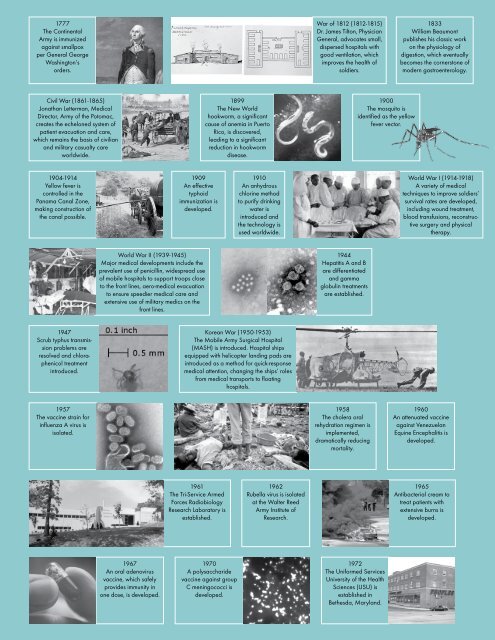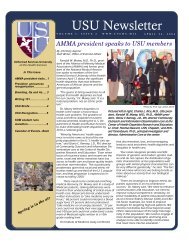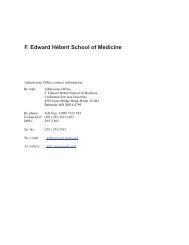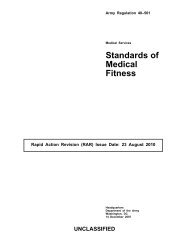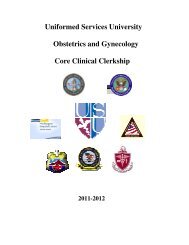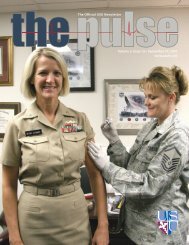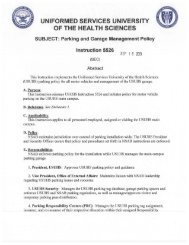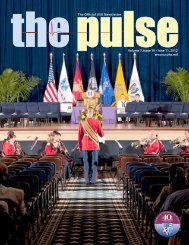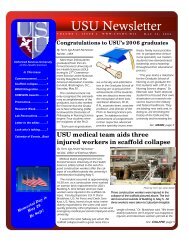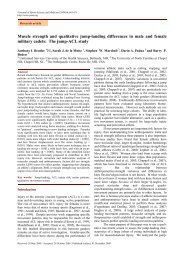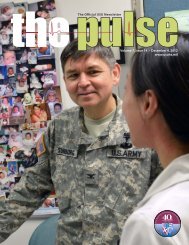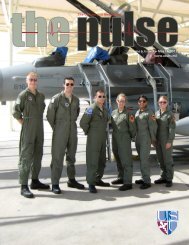A HISTORY OF SUCCESSThe American military medical community has produced significant research and clinical advancesthrough <strong>the</strong> years. The First World War saw <strong>the</strong> massive application <strong>of</strong> modern medicine includingimmunization, advanced surgery, use <strong>of</strong> motor ambulances, management <strong>of</strong> shock and treatment<strong>of</strong> psychiatric disorders. World War II brought widespread use <strong>of</strong> penicillin, mobile hospitals andextensive use <strong>of</strong> military medics on <strong>the</strong> front lines.Today, military medicine continues to lead <strong>the</strong> way in research and clinical care. The <strong>Uniformed</strong><strong>Services</strong> <strong>University</strong> <strong>of</strong> <strong>the</strong> <strong>Health</strong> <strong>Sciences</strong> (USU) plays a pivotal role in conducting military medicalresearch, and providing consultation and education programs that help <strong>the</strong> country face <strong>the</strong> manychallenges <strong>of</strong> a nation at war.The university is engaged in a wide array <strong>of</strong> research and training in areas such as traumatic brain injury(TBI), Post Traumatic Stress Disorder (PTSD), emerging infectious diseases and supporting <strong>the</strong> continuum<strong>of</strong> care from battlefield through rehabilitation to return to <strong>the</strong> workforce.“WEST POINT” OF MILITARY MEDICINEAt <strong>the</strong> end <strong>of</strong> World War II, <strong>the</strong> United Statesmilitary discharged more than 10 million menand women. Among those who left service werethousands <strong>of</strong> physicians who returned to civilianpractice. Years later, recognizing <strong>the</strong> urgent needfor career military physicians, Congressman F.Edward Hébert (D-LA) introduced legislation toestablish a “West Point for doctors”— a universityoperated by <strong>the</strong> Department <strong>of</strong> Defense (DoD) t<strong>of</strong>oster a strong military medical system.USU was established by Congress in 1972.The university’s curriculum is similar to that <strong>of</strong> itscivilian counterparts, but it also provides additionalspecialized educational elements geared towardsproducing career uniformed <strong>of</strong>ficers.PREPARING FOR THE FUTUREThe university educates and trains essential healthcare providers to face today’s challenges, and it isdeeply committed to <strong>the</strong> future <strong>of</strong> military medicine.Congress’ approval <strong>of</strong> <strong>the</strong> 2005 recommendationsToday, one in four active-duty physicians are USUalumni. <strong>University</strong> graduates serve in key capacities,including significant leadership positions,critical to <strong>the</strong> successful operation <strong>of</strong> <strong>the</strong> militarymedical and public health systems. Among <strong>the</strong>roles in which alumni have distinguished <strong>the</strong>mselvesare as members <strong>of</strong> <strong>the</strong> White House Presidentialmedical detail, heading terrorism and disasteremergency preparedness and response teamsand providing care and medical leadership duringoverseas military operations. USU’s relevance isconsiderable, more so today than at any point inits history. In a rapidly changing world, universitygraduates are shaping <strong>the</strong> future <strong>of</strong> military andpublic health.<strong>of</strong> <strong>the</strong> Base Realignment and Closure committeepaves <strong>the</strong> way for <strong>the</strong> university’s future as astate-<strong>of</strong>-<strong>the</strong>-art academic health center. CombiningWalter Reed Army Medical Center and <strong>the</strong>National Naval Medical Center —with USU at itsacademic core—<strong>the</strong> Walter Reed National MilitaryMedical Center will create a world-class academichealth system that <strong>of</strong>fers <strong>the</strong> highest quality care,distinguished health education and exemplarybasic and applied research.“While approximately one quarter <strong>of</strong> all new physiciansentering <strong>the</strong> military today are USU alumni, <strong>the</strong>y have adisproportionate impact on military leadership by dint<strong>of</strong> <strong>the</strong>ir specialized training and preparation as leaders.”S. Ward Casscells, III, M.D.,Assistant Secretary <strong>of</strong> Defense for <strong>Health</strong> Affairs (pictured center)2
1777The ContinentalArmy is immunizedagainst smallpoxper General GeorgeWashington’sorders.War <strong>of</strong> 1812 (1812-1815)Dr. James Tilton, PhysicianGeneral, advocates small,dispersed hospitals withgood ventilation, whichimproves <strong>the</strong> health <strong>of</strong>soldiers.1833William Beaumontpublishes his classic workon <strong>the</strong> physiology <strong>of</strong>digestion, which eventuallybecomes <strong>the</strong> cornerstone <strong>of</strong>modern gastroenterology.Civil War (1861-1865)Jonathan Letterman, MedicalDirector, Army <strong>of</strong> <strong>the</strong> Potomac,creates <strong>the</strong> echeloned system <strong>of</strong>patient evacuation and care,which remains <strong>the</strong> basis <strong>of</strong> civilianand military casualty careworldwide.1899The New Worldhookworm, a significantcause <strong>of</strong> anemia in PuertoRico, is discovered,leading to a significantreduction in hookwormdisease.1900The mosquito isidentified as <strong>the</strong> yellowfever vector.1904-1914Yellow fever iscontrolled in <strong>the</strong>Panama Canal Zone,making construction <strong>of</strong><strong>the</strong> canal possible.1909An effectivetyphoidimmunization isdeveloped.1910An anhydrouschlorine methodto purify drinkingwater isintroduced and<strong>the</strong> technology isused worldwide.World War I (1914-1918)A variety <strong>of</strong> medicaltechniques to improve soldiers’survival rates are developed,including wound treatment,blood transfusions, reconstructivesurgery and physical<strong>the</strong>rapy.World War II (1939-1945)Major medical developments include <strong>the</strong>prevalent use <strong>of</strong> penicillin, widespread use<strong>of</strong> mobile hospitals to support troops closeto <strong>the</strong> front lines, aero-medical evacuationto ensure speedier medical care andextensive use <strong>of</strong> military medics on <strong>the</strong>front lines.1944Hepatitis A and Bare differentiatedand gammaglobulin treatmentsare established.1947Scrub typhus transmissionproblems areresolved and chloraphenicoltreatmentintroduced.Korean War (1950-1953)The Mobile Army Surgical Hospital(MASH) is introduced. Hospital shipsequipped with helicopter landing pads areintroduced as a method for quick-responsemedical attention, changing <strong>the</strong> ships’ rolesfrom medical transports to floatinghospitals.1957The vaccine strain forinfluenza A virus isisolated.1958The cholera oralrehydration regimen isimplemented,dramatically reducingmortality.1960An attenuated vaccineagainst VenezuelanEquine Encephalitis isdeveloped.1961The Tri-Service ArmedForces RadiobiologyResearch Laboratory isestablished.1962Rubella virus is isolatedat <strong>the</strong> Walter ReedArmy Institute <strong>of</strong>Research.1965Antibacterial cream totreat patients wi<strong>the</strong>xtensive burns isdeveloped.1967An oral adenovirusvaccine, which safelyprovides immunity inone dose, is developed.1970A polysaccharidevaccine against groupC meningococci isdeveloped.1972The <strong>Uniformed</strong> <strong>Services</strong><strong>University</strong> <strong>of</strong> <strong>the</strong> <strong>Health</strong><strong>Sciences</strong> (USU) isestablished inBe<strong>the</strong>sda, Maryland.


